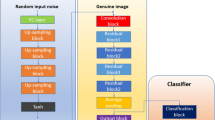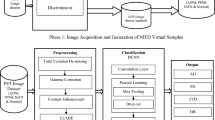Abstract
A major research subject in recent times is Alzheimer’s disease (AD) due to the growth and considerable societal impacts on health. So, the detection of AD is essential for medication care. Early detection of AD is critical for effective treatment, and monitoring the time period between normal aging’s unavoidable cognitive loss and dementia’s more catastrophic degradation is common practice. The deep learning method for early diagnosis and automated categorization of AD has suddenly gained a lot of attention since rapid advancement in the field of GANs approaches has now been used in the clinical research sector. Many recent studies using brain MRI images and convolutional neural networks (CNNs) to identify Alzheimer’s disease have yielded promising results. Instead of adequately engaging with the lack of real data, many research papers have focused on prediction. The main purpose of this paper is to do this by generating synthetic MRI images using a series of DCGANs. This paper demonstrates the effectiveness of this concept by cascading DCGANs that imitate different stages of Alzheimer’s disease and utilizing SRGANs to enhance the resolution of MRI scans. The purpose of this research is to come forward and tell if an individual might just get Alzheimer’s disease. CNN, DCGANs, and SRGANs are used in this paper to present a deep learning-based approach that improves classification and prediction accuracy to 99.7% and also handles the lack of data and the resolution of data.




















Similar content being viewed by others
References
Bai, T.; Du, M.; Zhang, L.; Ren, L.; Ruan, L.; Yang, Y.; Qian, G.; Meng, Z.; Zhao, L.; Deen, M.J.: A novel Alzheimer’s disease detection approach using GAN-based brain slice image enhancement. Neurocomputing 492, 353–369 (2022). https://doi.org/10.1016/j.neucom.2022.04.012
Zhao, Y.; Ma, B.; Che, T.; Li, Q.; Zeng, D.; Wang, X.; Li, S.: Multi-view prediction of Alzheimer’s disease progression with end-to-end integrated framework. J. Biomed. Inform. 125, 103978 (2021). https://doi.org/10.1016/j.jbi.2021.103978
Jo, T.; Nho, K.; Saykin, A.J.: Deep learning in Alzheimer’s disease: diagnostic classification and prognostic prediction using neuroimaging data. Front. Aging Neurosci. 11(2), 220–234 (2019). https://doi.org/10.3389/fnagi.2019.00220
Bowles, C.; Gunn, R.; Hammers, A.; Rueckert, D.: Modelling the progression of Alzheimer’s disease in MRI using generative adversarial networks. In: Proc. SPIE, vol. 10574, p. 105741 (2018). https://doi.org/10.1117/12.2293256
Lin, W.; Tong, T.; Gao, Q.; Guo, D.; Du, X.; Yang, Y.; Guo, G.; Xiao, M.; Du, M.; Qu, X.: Convolutional neural networks-based MRI image analysis for the Alzheimer’s disease prediction from mild cognitive impairment. Front. Neurosci. 12(777), 1–13 (2018). https://doi.org/10.3389/fnins.2018.00777
Lin, W.; Lin, W.; Chen, G.; Zhang, H.; Gao, Q.; Huang, Y.; Tong, T.; Du, M.: Bidirectional mapping of brain MRI and pet with 3D reversible GAN for the diagnosis of Alzheimer’s disease. Front. Neurosci. 15(6013), 1–13 (2021). https://doi.org/10.3389/fnins.2021.646013
Zhao, Y.; Ma, B.; Jiang, P.; Zeng, D.; Wang, X.; Li, S.: Prediction of Alzheimer’s disease progression with multi-information generative adversarial network. IEEE J. Biomed. Health Inform. 25(3), 711–719 (2021). https://doi.org/10.1109/JBHI.2020.3006925
AbdulAzeem, Y.; Bahgat, W.M.; Badawy, M.: A CNN based framework for classification of Alzheimer’s disease. Neural Comput. Appl. 33(16), 10415–10428 (2021). https://doi.org/10.1007/s00521-021-05799-w
Roychowdhury, S.; Roychowdhury, S.: A modular framework to predict Alzheimer’s disease progression using conditional generative adversarial networks 2, 1–8 (2020). https://doi.org/10.1109/IJCNN48605.2020.9206875
Radford, A.; Metz, L.; Chintala, S.: Unsupervised representation learning with deep convolutional generative adversarial networks 1, 1–16 (2015). https://doi.org/10.48550/ARXIV.1511.06434
Ledig, C.; Theis, L.; Huszar, F.; Caballero, J.; Cunningham, A.; Acosta, A.; Aitken, A.; Tejani, A.; Totz, J.; Wang, Z.; Shi, W.: Photo-realistic single image super-resolution using a generative adversarial network 12, 105–114 (2017). https://doi.org/10.1109/CVPR.2017.19
Liu, S.; Song, Y.; Cai, W.; Pujol, S.; Kikinis, R.; Wang, X.; Feng, D.: Multifold Bayesian kernelization in Alzheimer’s diagnosis. In: Mori, K., Sakuma, I., Sato, Y., Barillot, C., Navab, N. (eds.) Medical Image Computing and Computer-Assisted Intervention—MICCAI 2013, pp. 303–310. Springer, Berlin, Heidelberg (2013)
Martin, R.C.; Gerstenecker, A.T.; Triebel, K.; Falola, M.I.; McPherson, T.; Cutter, G.R.; Marson, D.C.: Declining financial capacity in mild cognitive impairment: a six-year longitudinal study. Archiv. Clin. Neuropsychol. 34, 152–161 (2019). https://doi.org/10.1093/arclin/acy030
Mirza, M.; Osindero, S.: Conditional generative adversarial nets. CoRR 1411, p. 1784 (2014). https://doi.org/10.48550/arXiv.1411.1784
Simonyan, K.; Zisserman, A.: Two-stream convolutional networks for action recognition in videos. CoRR 1406, p. 2199 (2014). https://doi.org/10.48550/arXiv.1406.2199
Zhang, D.; Wang, Y.: Multimodal classification of Alzheimer’s disease and mild cognitive impairment. NeuroImage 55, 856–867 (2011). https://doi.org/10.1016/j.neuroimage.2011.01.008
Zhang, J.; Liu, M.; An, L.; Gao, Y.; Shen, D.: Alzheimer’s disease diagnosis using landmark-based features from longitudinal structural MR images. IEEE J. Biomed. Health Inform. 21(6), 1607–1616 (2017). https://doi.org/10.1109/JBHI.2017.2704614
Sinharoy, R.; Sen, A.: Cardiovascular disease prediction using ensemble classification algorithm in machine learning 12, 2628–2633 (2022). https://doi.org/10.21917/ijsc.2022.0366
Kazuhiro, K.: Generative adversarial networks for the creation of realistic artificial brain magnetic resonance images. Tomography 4, 159–163 (2018). https://doi.org/10.18383/j.tom.2018.00042
King, R.D.; Brown, B.; Hwang, M.; Jeon, T.; George, A.T.: Fractal dimension analysis of the cortical ribbon in mild Alzheimer’s disease. Neuroimage 53, 471–479 (2010). https://doi.org/10.1016/j.neuroimage.2010.06.050
Kruger, A.: Implementation of a fast box-counting algorithm. Comput. Phys. Commun. 98(1), 224–234 (1996). https://doi.org/10.1016/0010-4655(96)00080-X
Li, J.; Du, Q.; Sun, C.: An improved box-counting method for image fractal dimension estimation. Pattern Recognit. 42, 2460–2469 (2009). https://doi.org/10.1016/j.patcog.2009.03.001
Liu, S.; Liu, S.; Cai, W.; Che, H.; Pujol, S.; Kikinis, R.; Feng, D.; Fulham, M.J.: ADNI: multimodal neuroimaging feature learning for multiclass diagnosis of Alzheimer’s disease. IEEE Trans. Biomed. Eng. 62(4), 1132–1140 (2015). https://doi.org/10.1109/TBME.2014.2372011
Yu, W.; Lei, B.; Wang, S.; Liu, Y.; Feng, Z.; Hu, Y.; Shen, Y.; Ng, M.K.: Morphological feature visualization of Alzheimer’s disease via multidirectional perception GAN. IEEE Trans. Neural Netw. Learn. Syst. 2, 1–15 (2022). https://doi.org/10.1109/TNNLS.2021.3118369
Li, X.; Du, Z.; Huang, Y.; Tan, Z.: A deep translation (GAN) based change detection network for optical and SAR remote sensing images. ISPRS J. Photogramm. Remote Sens. 179, 14–34 (2021). https://doi.org/10.1016/j.isprsjprs.2021.07.007
Qu, C.; Zou, Y.; Ma, Y.; Chen, Q.; Luo, J.; Fan, H.; Jia, Z.; Gong, Q.; Chen, T.: Diagnostic performance of generative adversarial network-based deep learning methods for Alzheimer’s disease: a systematic review and meta-analysis. Front. Aging Neurosci. 14, 841696 (2022). https://doi.org/10.3389/fnagi.2022.841696
Zhou, X.; Qiu, S.; Joshi, P.S.; Xue, C.; Killiany, R.J.; Mian, A.Z.; Chin, S.P.; Au, R.; Kolachalama, V.B.: Enhancing magnetic resonance imaging-driven Alzheimer’s disease classification performance using generative adversarial learning. Alzheimers Res. Ther. 13(1), 60 (2021). https://doi.org/10.1186/s13195-021-00797-5
Sajjad, M.; Ramzan, F.; Khan, M.U.G.; Rehman, A.; Kolivand, M.; Fati, S.M.; Bahaj, S.A.: Deep convolutional generative adversarial network for Alzheimer’s disease classification using positron emission tomography (PET) and synthetic data augmentation. Microsc. Res. Tech. 84(12), 3023–3034 (2021). https://doi.org/10.1002/jemt.23861
Li, F.; Cheng, D.; Liu, M.: Alzheimer’s disease classification based on combination of multi-model convolutional networks. In: 2017 IEEE International Conference on Imaging Systems and Techniques (IST), vol. 1, pp. 1–5 (2017). https://doi.org/10.1109/IST.2017.8261566
Hosseini-Asl, E.; Ghazal, M.; Mahmoud, A.; Aslantas, A.; Shalaby, A.M.; Casanova, M.F.; Barnes, G.N.; Gimel’farb, G.; Keynton, R.; El-Baz, A.: Alzheimer’s disease diagnostics by a 3d deeply supervised adaptable convolutional network. Front. Biosci. (Landmark Ed.) 23(3), 584–596 (2018). https://doi.org/10.2741/4606
Suk, H.-I.; Lee, S.-W.; Shen, D.; Initiative, T.A.D.N.: Latent feature representation with stacked auto-encoder for AD/MCI diagnosis. Brain Struct. Funct. 220(2), 841–859 (2015). https://doi.org/10.1007/s00429-013-0687-3
Wang, H.; Shen, Y.; Wang, S.; Xiao, T.; Deng, L.; Wang, X.; Zhao, X.: Ensemble of 3d densely connected convolutional network for diagnosis of mild cognitive impairment and Alzheimer’s disease. Neurocomputing 333, 145–156 (2019). https://doi.org/10.1016/j.neucom.2018.12.018
Feng, W.; Halm-Lutterodt, N.V.; Tang, H.; Mecum, A.; Mesregah, M.K.; Ma, Y.; Li, H.; Zhang, F.; Wu, Z.; Yao, E.; Guo, X.: Automated MRI-based deep learning model for detection of Alzheimer’s disease process. Int. J. Neural Syst. 30(06), 2050032 (2020). https://doi.org/10.1142/S012906572050032X. PMID: 32498641
Hussain, E.; Hasan, M.; Hassan, S.Z.; Hassan Azmi, T.; Rahman, M.A.; Zavid Parvez, M.: Deep learning based binary classification for Alzheimer’s disease detection using brain MRI images. In: 2020 15th IEEE Conference on Industrial Electronics and Applications (ICIEA), vol. 1, pp. 1115–1120 (2020). https://doi.org/10.1109/ICIEA48937.2020.9248213
Magnin, B.; Mesrob, L.; Kinkingnéhun, S.; Pélégrini-Issac, M.; Colliot, O.; Sarazin, M.; Dubois, B.; Lehéricy, S.; Benali, H.: Support vector machine-based classification of Alzheimer’s disease from whole-brain anatomical MRI. Neuroradiology 51(2), 73–83 (2009). https://doi.org/10.1007/s00234-008-0463-x
Ahmed, B.; Mizotin, O.; Benois-Pineau, M.: Alzheimer’s disease diagnosis on structural MR images using circular harmonic functions descriptors on hippocampus and posterior cingulate cortex. Comput. Med. Imaging Graph. 44, 13–25 (2015). https://doi.org/10.1016/j.compmedimag.2015.04.007
Khvostikov, A.; Aderghal, K.; Krylov, A.; Catheline, G.; Benois-Pineau, J.: 3D inception-based CNN with SMRI and MD-DTI data fusion for Alzheimer’s disease diagnostics 3, 102–113 (2018). https://doi.org/10.13140/RG.2.2.30737.28006
Korolev, S.; Safiullin, A.; Belyaev, M.; Dodonova, Y.: Residual and plain convolutional neural networks for 3D brain MRI classification. In: 2017 IEEE 14th International Symposium on Biomedical Imaging (ISBI 2017), vol. 1, pp. 835–838 (2017). https://doi.org/10.1109/ISBI.2017.7950647
Pan, Y.; Liu, M.; Lian, C.; Zhou, T.; Xia, Y.; Shen, D.: Synthesizing missing pet from MRI with cycle-consistent generative adversarial networks for Alzheimer’s disease diagnosis. Med. Image Comput. Comput. Assist. Interv. 11072, 455–463 (2018). https://doi.org/10.1007/978-3-030-00931-1_52
Logan, R.; Williams, B.G.; Ferreira da Silva, M.; Indani, A.; Schcolnicov, N.; Ganguly, A.; Miller, S.J.: Deep convolutional neural networks with ensemble learning and generative adversarial networks for Alzheimer’s disease image data classification. Front. Aging Neurosci. 13, 720226 (2021)
Acknowledgements
We sincerely acknowledge the editor as well as the reviewers for their insightful comments that helped to enhance the manuscript. The Alzheimer’s Disease Neuroimaging Initiative shared the data for this investigation.
Funding
This research was self-funded.
Author information
Authors and Affiliations
Contributions
RS led the implementations, data preprocessing, formal analysis, and experiments, wrote the original manuscript, and revised the manuscript. AS supervised and managed the research. RS contributed to the article and approved the submitted version.
Corresponding author
Ethics declarations
Conflict of interest
The authors declared that they have no conflicts of interest in this research. The authors certify that they are free of any known financial conflicts of interest or close personal ties that might have looked to have affected the research presented in this study.
Rights and permissions
Springer Nature or its licensor (e.g. a society or other partner) holds exclusive rights to this article under a publishing agreement with the author(s) or other rightsholder(s); author self-archiving of the accepted manuscript version of this article is solely governed by the terms of such publishing agreement and applicable law.
About this article
Cite this article
SinhaRoy, R., Sen, A. A Hybrid Deep Learning Framework to Predict Alzheimer’s Disease Progression Using Generative Adversarial Networks and Deep Convolutional Neural Networks. Arab J Sci Eng 49, 3267–3284 (2024). https://doi.org/10.1007/s13369-023-07973-9
Received:
Accepted:
Published:
Issue Date:
DOI: https://doi.org/10.1007/s13369-023-07973-9




